
Speed skating is a competitive form of ice skating in which the competitors race each other in travelling a certain distance on skates. Types of speed skating are long-track speed skating, short-track speed skating, and marathon speed skating. In the Olympic Games, long-track speed skating is usually referred to as just "speed skating", while short-track speed skating is known as "short track". The International Skating Union (ISU), the governing body of competitive ice sports, refers to long track as "speed skating" and short track as "short track skating".
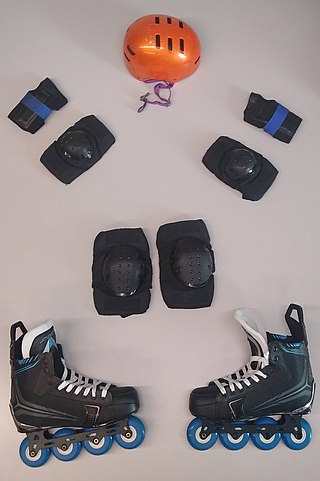
Inline skates are a type of roller skate used for inline skating. Unlike typical roller skates, which have two front and two rear wheels, inline skates typically have two to five wheels arranged in a single line. Some, especially those for recreation, have a rubber "stop" or "brake" block attached to the rear of one or occasionally both of the skates so that the skater can slow down or stop by leaning back on the foot with the brake skate.

Roller skating is the act of travelling on surfaces with roller skates. It is a recreational activity, a sport, and a form of transportation. Roller rinks and skate parks are built for roller skating, though it also takes place on streets, sidewalks, and bike paths.

Inline speed skating is the roller sport of racing on inline skates. The sport may also be called inline racing or speed skating by participants. Although it primarily evolved from racing on traditional roller skates, the sport is similar enough to ice speed skating that many competitors are known to switch between inline and ice speed skating according to the season.

Inline skating is a multi-disciplinary sport and can refer to a number of activities practiced using inline skates. Inline skates typically have two to five polyurethane wheels depending on the style of practice, arranged in a single line by a metal or plastic frame on the underside of a boot. The in-line design allows for greater speed and maneuverability than traditional roller skates. Following this basic design principle, inline skates can be modified to varying degrees to accommodate niche disciplines.

A racing bicycle, also known as a road bike is a bicycle designed for competitive road cycling, a sport governed by and according to the rules of the Union Cycliste Internationale (UCI).

A track bicycle or track bike is a bicycle optimized for racing at a velodrome or outdoor track. Unlike road bicycles, the track bike is a fixed-gear bicycle; thus, it has only a single gear ratio and has neither a freewheel nor brakes. Tires are narrow and inflated to high pressure to reduce rolling resistance.

Roller skates are shoes or bindings that fit onto shoes that are worn to enable the wearer to roll along on wheels. The first roller skate was an inline skate design, effectively an ice skate with wheels replacing the blade. Later the "quad skate" style became more popular, consisting of four wheels arranged in the same configuration as a typical car.
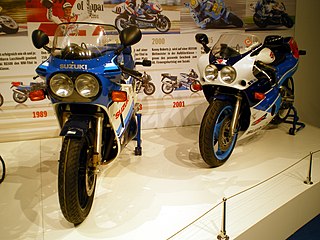
Suzuki GSX-R is a series of sports motorcycles made by Japanese automotive manufacturer Suzuki since 1984.
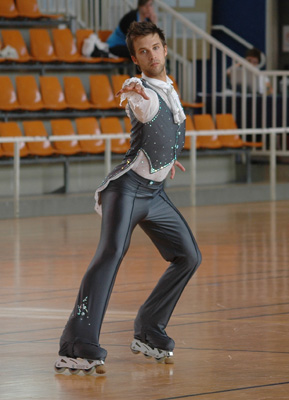
Artistic roller skating is a competitive sport similar to figure skating but where competitors wear roller skates instead of ice skates. Within artistic roller skating, there are several disciplines:
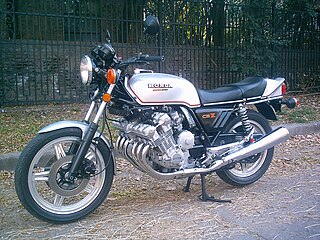
The Honda CBX sports motorcycle was manufactured by Honda from 1978 to 1982. With a 1047cc inline six-cylinder engine producing 105 bhp (78 kW), it was the flagship of the Honda range. The CBX was well-received by the press, but was outsold by its sibling introduced in late 1979, the Honda CB900F.

Mogema is a registered brand trademark owned by Sportsinline International BV, a Dutch company that specialized in the design and production of inline- and ice speedskating products. Sportsinline International was founded by the parent company of the Mogema group to design and produce speedskating products under the Mogema name. The company approached Design Engineer Diederik Hol to design a whole range of ice and inline speedskates that evolved under Hol's direction into Mogema's modern product line.

Roller skiing is an off-snow equivalent to cross-country skiing. Roller skis have wheels on their ends and are used on a hard surface, to emulate cross-country skiing. The skiing techniques used are very similar to techniques used in cross-country skiing on snow.
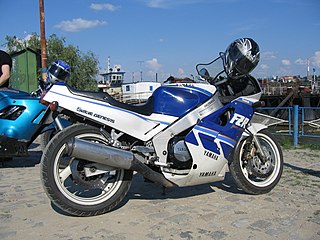
The Yamaha FZR1000 is a motorcycle produced by Yamaha from 1987 to 1995. Classed as a sports motorcycle.

A motorcycle frame is a motorcycle's core structure. It supports the engine, provides a location for the steering and rear suspension, and supports the rider and any passenger or luggage. Also attached to the frame are the fuel tank and battery. At the front of the frame is found the steering head tube that holds the pivoting front fork, while at the rear there is a pivot point for the swingarm suspension motion. Some motorcycles include the engine as a load-bearing stressed member; while some other bikes do not use a single frame, but instead have a front and a rear subframe attached to the engine.
Diederik Hol is a Dutch design engineer, designer of the Dual Box inline skate frame and the Narrow Shape Cross-Section (NSX) ice blade, and founder/director of skate company CadoMotus Skating BV.

Aggressive inline skating is a sub-discipline of inline skating in the action sports canon. Aggressive inline skates are specially modified to accommodate grinds and jumps. Aggressive skating can take place on found street obstacles or at skate parks.

Jordan Malone is an American short track speed skater who was a member of the US Olympic Team for the 2010 Winter Olympics in Vancouver, British Columbia. He is from Denton, Texas, and is an alumnus of the Texas Tech University Independent School District. Jordan competed in the 2014 Olympic Games in Sochi, Russia. During one of the Olympic days, Malone got stuck in a bathroom and, later that same day, got stuck in an elevator.

Joey Mantia is an American speed skater and inline speed skater, an Olympic bronze medalist, 28-time world champion, and a world record holder. He also won two gold medals at the 2003 Pan American Games and a gold medal at the 2007 Pan American Games. He won the American Speed Skater of the Year award three times in a row, in 2005, 2006, and 2007, and the 2007 Elmer Ringeisen Sportsmanship Award. In October 2010, after winning two world titles at the inline skating championships in Colombia, he was ranked second among male competitors in the USOC Athlete of the Month competition.

World Skate is the only governing body in the world for all sports performed on skating wheels. The organisation is the successor of the Fédération Internationale de Roller Sports (FIRS) founded on 21 April 1924.

















